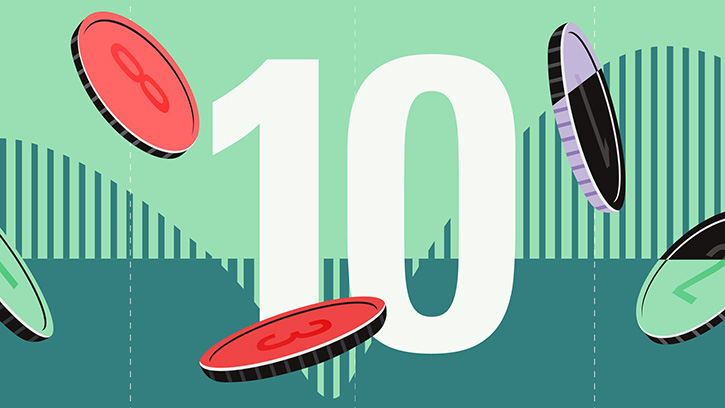Rolle im Portfolio
Db x-trackers MSCI Pacific provides exposure to mid- and large cap equities in developed countries of the Asia-Pacific region, excluding Japan.
The MSCI Pacific ex-Japan Index is heavily concentrated, with almost two thirds of its total allocation represented by Australia and over half dedicated towards the financial sector. This ETF is therefore best used as a tactical bet, specifically for investors bullish on Australia’s economy and the financial sector in the Asia-Pacific region. Investors who want exposure to emerging-markets trends but via companies domiciled in well-developed countries in Asia-Pacific can also look to this fund.
This product does not hedge its foreign-currency risk. Given its exposure to Australia, investors should be aware of the volatility of the Australian dollar when looking at this fund. As commodity exports constitute a large portion of the country’s economy, the Australian dollar is sensitive to price fluctuations in the commodity markets, which have recently been shifted downwards.
This fund does not pay out dividends and may not be suitable for income-seeking investors.
Fundamentale Analyse
Australia, rich in natural resources, has benefited from remarkable economic growth during the commodity supercycle starting in the mid-2000s. Over the past few decades, Australia’s prosperity moved in tandem with emerging-markets trends, markedly through commodity exports to developing Asian countries. Now, the situation is changing. The slump in commodity prices that started in 2014, as well as headwinds from China--Australia’s main trading partner--dwarfed the annual gross domestic product figure from over 4.5% in 2012 to 2% in the second quarter of 2015. China’s economy is shifting from a heavy manufacturing economic growth model to a consumption-driven and service-oriented one, resulting in less demand for Australia’s raw materials.
Over half of the MSCI Pacific Ex-Japan Index Australia allocation is dedicated towards the financial sector. The Commonwealth Bank of Australia represents nearly 7% of total index allocation, while Westpac Banking Corp accounts for approximately 5.4%. These banks continue to leverage strong competitive advantages to generate growth profits and dividends despite patchy economic conditions across the broader economy.
Hong Kong accounts for this ETF’s next-largest country allocation, representing over a third of total portfolio exposure. Constituents are mainly financials, which include large-cap property firms and banks. Rock-bottom US interest rates, as well as sky-high Chinese investment in the Hong Kong property market has moved real estate prices into bubblelike territory.
Singapore is considered a developed economy, even though it was founded in 1965. The country’s history of rapid growth can be attributed to its clean government, strong commercial laws, careful state-planning, strategic location, and a manageable population. Singapore’s largest export markets are Greater China, Malaysia, and Indonesia, and its main export products include electronics and chemicals. Good corporate governance as well as a highly developed and liquid capital market have contributed to this economy’s wealth. The Singaporean economy has shown signs of slowing though, mainly because of China.
In this portfolio, financials--which also include real estate firms--account for the largest sector among Singapore holdings. The largest big three banks include DBS Group Holdings, Oversea-Chinese Banking, and United Overseas Bank. All three have strong balance sheets offering a wide range of competitive products. Banks are leveraged cyclical businesses, and they tend to do better in good times and underperform in periods of economic stress, so the health of the broader economy is important for bank earnings and dividends.
Indexkonstruktion
The MSCI Pacific ex-Japan Index is a free-float market-cap-weighted index currently consisting of the 145 largest and most liquid stocks in Australia, Hong Kong, Singapore, New Zealand, and China. The index covers approximately 85% of the free-float-adjusted market capitalisation in each country. New index members must pass minimum requirements for liquidity and length of trading history. It is reviewed quarterly and rebalanced semiannually with new size cutoffs calculated. The index’s top country weightings are Australia (57%-62%), Hong Kong (26%-31%), and Singapore (10%-15%). Financials are by far the biggest sector component (53%-58%), followed by materials and industrials (7%-12% each). The top constituents are Commonwealth Bank of Australia (6%-7%), Westpac Banking (5%-6%), and AIA Group (5%-6%).
Fondskonstruktion
This ETF employs full replication to capture the performance of the MSCI Pacific ex-Japan Net Return Index, owning--to the extent that it’s possible and efficient--all the underlying constituents in the same proportion as its benchmark. This fund uses futures for cash equitisation purposes, which helps to minimise tracking error. The combined weight of these components is capped at 2% of the portfolio’s value, although internally a 1% target is aimed for. The fund engages in securities lending to enhance returns. As of this writing, the average annual percentage on loan was 2.37 (percent of AUM) of the portfolio with up to a maximum of 6.82 (percent of AUM). The lending programme added less than 0.01% net return to the fund. The amount of securities that can be lent is capped to 50% per fund. Deutsche Bank AG acts as the lending agent. Gross lending revenue is split 70/30 between the ETF and the lending agent, respectively.
Gebühren
This ETF’s total expense ratio is 0.45%, which is in the middle of the range for similar products. The goal of an index fund is to provide the returns of the index, less fees. Over the past three years, the annual tracking difference (fund return minus index return) has ranged from negative 0.66% to negative 0.35%, suggesting that the total cost of holding the fund varies from year to year. It can be higher or lower than the TER. Other costs potentially carried by the unitholder include bid-ask spreads and brokerage fees when buy and sell orders are placed for ETF shares.
Alternativen
Various providers offer ETFs tracking the MSCI Pacific ex-Japan Index benchmark including Amundi, iShares, HSBC, Lyxor, ComStage, and UBS. The iShares Core MSCI Pacific ex-Japan ETF charges the lowest total expense ratio of 0.20%.
As an alternative, investors can also look to ETFs tracking the MSCI AC Asia Pacific ex-Japan Index. This benchmark offers broader and more comprehensive equity exposure in the Asia-Pacific region. The largest country exposure is to China (20%-24%), followed by Australia (18%-22%), then South Korea (12%-16%) and Taiwan (9%-13%). Db x-trackers and Lyxor both provide products replicating this benchmark charging total expense ratios of 0.60% and 0.50%, respectively.
The Vanguard FTSE Developed Asia Pacific Ex-Japan UCITS ETF provides exposure to Australia (38%-42%), South Korea (25%-29%), and Hong Kong (20%-24%). The TER is 0.22%.
In the strategic-beta department, PowerShares FTSE RAFI Asia Pacific Ex-Japan UCITS ETF (TER 0.49%) captures the performance of the equity markets in Australia (38%-43%), South Korea (26%-31%), Hong Kong (20%-25%), Singapore (6%-11%), and New Zealand (0%-4%). Companies are weighted by fundamental variables including book value, cash flow, sales, and dividends.
Alternatively, iShares Asia Pacific Dividend UCITS ETF (TER 0.59%) replicates the performance of 30 stocks with the highest dividend yields in the Asia-Pacific region. Top exposure is to Australia (50%-54%), followed by Hong Kong (15%-19%) and then New Zealand (10%-14%).

















